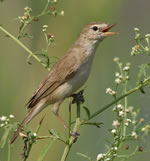Warblers

Facts about creatures
- Home
- Animal Classification
- Animal Habitats
- Amphibians
- Arthropods
- Bats
- Birds
- Carnivorans
- Cetaceans
- Chordates
- Crustaceans
- Dinosaurs
- Diprotodonts
- Elephants
- Fish
- Golden Mole
- Insects
- Lagomorphs
- Mammals
- Mammal Teeth
- Marsupial Mole
- Metamorphosis
- Mollusks
- Primates
- Reptiles
- Rodents
- Ruminants
- Soricomorphans
- Tenrec
- Tetrapods
- Vertebrates
Warblers
Warbler is a name that is used to describe a number of different groups of passerines with similar characteristics.
The different groups of warblers are not closely related to one another.
Warblers tend to be small, with brownish feathers.
The name “warbler” comes from the fact that these birds tend to be very vocal songbirds.
Warblers eat invertebrates, including insects, spiders snails, and small crustaceans. They also sometimes eat seeds and fruits.
The classification of these different types of unrelated birds into one category – warblers – is an example of a folk taxonomy, in which a culture categorizes organisms based on their observable characteristic.

Old World Warblers
Old world warblers make up the family Sylviidae.
They are sometimes called true warblers.
Old world warblers are between about 4 ½ and 7 ½ inches long.
They are migratory. They breed in Europe, parts of Asia and parts of Africa, and winter in Africa and tropical Asia.
They are monogamous.
Their nests are shaped like cups and are made of vegetable matter and cobwebs. A nest is often attached to reeds over water or to several twigs in a bush or thicket.
Both male and female help raise the young.

Australasian Warblers
Australasian warblers, also known as Australian warblers, belong to the family Acanthizidae.
This family includes three genera: thornbills (genus Acanthiza) gerygones (genus gerygone), and scrubwrens (genus Sericornis).
Australasian warblers live in Australia, New Zealand, Southeast Asia, Indonesia and the South Pacific.
They range from about 3 to about 7 ½ inches long.
Phylloscopidae
Phylloscopidae is a family of passerines that were once classified as old world warblers.
Although Phylloscopids also live in the old world – in Africa and Eurasia – DNA studies have shown that they belong to their own family.
Phylloscopidae includes the leaf warblers (genus Phylloscopus) and warblers of the genus Seicercus.
These birds often have green, brown or yellow coloring.
They live in trees, where they pick insects off of leaves.
Many Phylloscopids migrate for long distances.
Acrocephalidae
Acrocephalidae is a family of warblers that includes reed warblers, marsh warblers, swamp warblers, brush warblers and tree warblers.
Acrocephalids tend to be large for warblers.
They usually have olive brown feathers on top and yellow or beige feathers below.
Acrocephalids live in Africa, Eurasia and the Pacific. They were formerly classed as old world warblers, but DNA studies show that they belong to a different family.
The great reed warbler (Acrocephalus arundinaceus) breeds in Europe and western Asia and spends its winters in Africa from Liberia southward to South Africa.
It is usually between about 6 and 8 inches long.
The great reed warbler mostly eats insects.
It has a croaky song.
The great reed warbler builds its nest in reeds close to water.
The nest is hung around two or three reed stems. Long grass stems are interwoven with the reeds, creating a cylindrical structure that is lined with soft materials such as wool, flowers and feathers.
Olive Warbler
The olive warbler (Peucedramus taeniatus) is the only member of the family Peucedramidae.
It breeds in the southwestern United States and Mexico and winters in Central America.
Although it was originally classified as a new world warbler, DNA evidence shows that it does not belong to the same family.
Olive warblers are about 5 inches long and weigh less than half an ounce.
They have gray bodies. Their wings have some olive green and two white bars. Their underparts are white.
Males have orange breasts and a black patch that extends from the bill to behind the ear and looks like a mask.
Females and juveniles have yellow breasts and dark patches on their cheeks.
Olive warblers find food by foraging along tree branches.